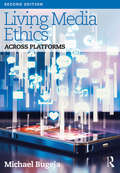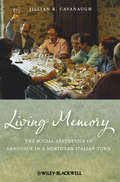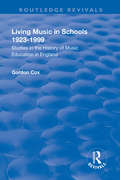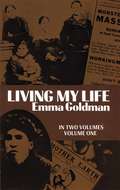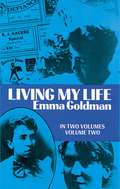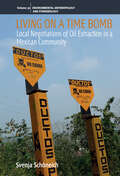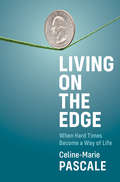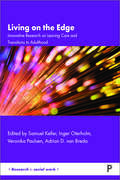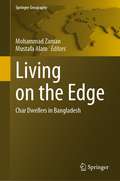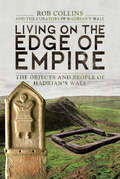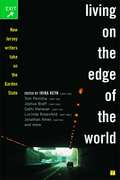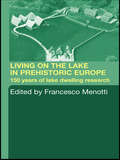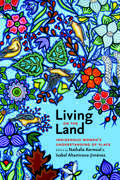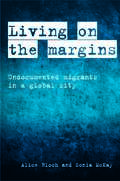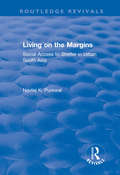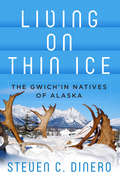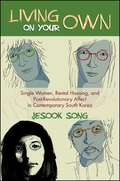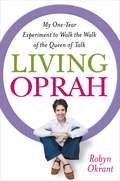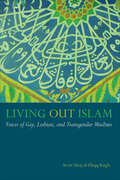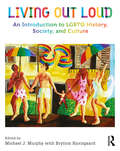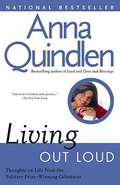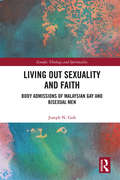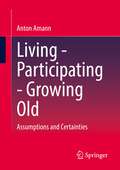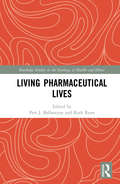- Table View
- List View
Living Media Ethics: Across Platforms
by Michael BugejaWinner of the Clifford G. Christians Award for Research in Media Ethics, Michael Bugeja’s Living Media Ethics posits that moral convergence is essential to address the complex issues of our high-tech media environment. As such the book departs from and yet complements traditional pedagogy in media ethics. Bugeja covers advertising, public relations and major branches of journalism, as well as major schools of philosophical thought and historical events that have shaped current media practices. Examining topics including responsibility, truth, falsehood, temptation, bias, fairness, and power, chapters encourage readers to develop a personal code of ethics that they can turn to throughout their careers. Each chapter includes exercises, as well as journal writing and creative assignments, designed to build, test, and enhance individual value systems. Unlike other texts, this media ethics book ends with an assignment to create a digital portfolio with personal ethics code aligned with a desired media position or company.
Living Memory: The Social Aesthetics of Language in a Northern Italian Town (Wiley Blackwell Studies in Discourse and Culture)
by Jillian R. CavanaughLiving Memory investigates the complex question of language and its place at the heart of Bergamasco culture in northern Italy. • Integrates extensive participant observation with sociolinguistic data collection • Reveals the political and social dynamics of a national language (Italian) and a local dialect (Bergamasco) struggling for survival • Introduces the original concept of the “social aesthetics of language”: the interweaving of culturally-shaped and emotionally felt dimensions of language-choice • Written to be accessible to students and specialists alike • Part of the Blackwell Studies in Discourse and Culture Series
Living Music in Schools 1923-1999: Studies in the History of Music Education in England (Routledge Revivals)
by Gordon CoxThis title was first published in 2002: This volume explores educational reforms and innovations in music teaching in England between 1923 and 1999. Gordon Cox investigates the key reforms which attempted to give life to music in schools, and describes teachers' reactions to such innovations. By taking classroom practice and teacher experiences as seriously as policy making and education rhetoric, this book broadens the horizons of historical investigation into music education.
Living My Life, Vol. 1
by Emma Goldman“You damn bitch of an anarchist, I wish I could get at you. I would tear your heart out and feed it to my dog.” This was one of the less obscene messages received by Emma Goldman (1869-1940), while in jail on suspicion of complicity in the assassination of McKinley. The most notorious woman of her day, she was bitterly hated by millions and equally revered by millions.The strong feelings she aroused are understandable. She was an alien, a practicing anarchist, a labor agitator, a pacifist in World War 1, an advocate of political violence, a feminist, a proponent of free love and birth control, a communist, a street-fighter for justice — all of which she did with strong intellect and boundless passion. Today, of course, many of the issues that she fought over are just as vital as they were then.Emma Goldman came from Russia at the age of 17. After an encounter with the sweatshop and an unfortunate marriage, she plunged into the bewildering intellectual and activist chaos that attended American social evolution around the turn of the twentieth century. She knew practically everyone of importance in radical circles. She dominated many areas of the radical movement, lecturing, writing, haranguing, and publishing to awaken the world to her ideas. After World War I she was deported to Russia, where she soon discovered that anarchists were no better liked than in America, despite Lenin’s first gesture of welcome. She escaped with her life but never was allowed to return to the United States.Emma Goldman was a devastatingly honest woman, who spared herself as little as she spared anyone else. From her account the reader can gain insight into a curious personality type of recurrent interest: a woman who devoted her life to eliminating suffering, yet could make a bomb or assist in staging an assassination. Equally interesting are her comments on other radicals of the period, such as Kropotkin, Berkman, Mooney, Lenin, Trotsky, Haywood, Most, the Haymarket martyrs, and many others. Her autobiography, written with vigor, ranks among the finest in the English language.
Living My Life, Vol. 1
by Emma GoldmanThe no-holds-barred account by American anarchist Goldman relates her philosophical and political journey through life. Explore the politicization of the young Russian immigrant as she arrives in the United States in 1886, and how she wends her way through the labyrinth of American, Russian, and European politics over the next 40 years.
Living on a Time Bomb: Local Negotiations of Oil Extraction in a Mexican Community (Environmental Anthropology and Ethnobiology #30)
by Svenja SchöneichProviding a holistic understanding of extensive oil extraction in rural Mexico, this book focuses on a campesino community, where oil extraction is deeply inscribed into the daily lives of the community members. The book shows how oil shapes the space where it is extracted in every aspect and produces multiple uncertainties. The community members express these uncertainties using the metaphor of the time bomb. The book shows how they find ways to "live off the time bomb" by using mechanisms of short-term coping and long-term adaptation and thus, developing the capability to determine their lives despite the ever-changing challenges.
Living on the Edge: When Hard Times Become a Way of Life
by Celine-Marie PascaleFor the majority of Americans, hard times have long been a way of life. Some work multiple low-wage jobs, others face the squeeze of stagnant wages and rising costs of living. Sociologist Celine-Marie Pascale talked with people across Appalachia, at the Standing Rock and Wind River reservations, and in the bustling city of Oakland, California. Their voices offer a wide range of experiences that complicate dominant national narratives about economic struggles. Yet Living on the Edge is about more than individual experiences. It’s about a nation in a deep economic and moral crisis. It’s about the long-standing collusion between government and corporations that prioritizes profits over people, over the environment, and over the nation’s well-being. It’s about how racism, sexism, violence, and the pandemic shape daily experience in struggling communities. And, ultimately, it’s a book about hope that lays out a vision for the future as honest as it is ambitious. Most people in the book are not progressives; none are radicals. They’re hard-working people who know from experience that the current system is unsustainable. Across the country people described the need for a living wage, accessible health care, immigration reform, and free education. Their voices are worth listening to.
Living on the Edge: Innovative Research on Leaving Care and Transitions to Adulthood
by Samuel Keller, Inger Oterholm, Veronika Paulsen and Adrian D. van BredaEPDF and EPUB available Open Access under CC-BY licence. Young people transitioning out of care towards independence, work and adulthood are on the edge of these phases of life. Considering previously neglected groups of care leavers such as unaccompanied migrants, street youth, those leaving residential care, young parents and those with a disability, this book presents cutting-edge research from emerging global scholars. The collection addresses the precarity experienced by many care leavers, who often lack the social capital and resources to transition into stable education, employment and family life. Including the voices of care leavers throughout, it makes research relevant to practitioners and policymakers aiming to enable, rather than label, vulnerable groups.
Living on the Edge: Char Dwellers in Bangladesh (Springer Geography)
by Mohammad Zaman Mustafa AlamIn Bangladesh, the chars within the river channels are an important part of its landscape. However, these land masses continue to remain isolated, deprived of services, and pockets of poverty in the country. The char dwellers are vulnerable to natural hazards like flood and erosion. In addition to these hazards, the coastal chars are faced with the imminent problem of widespread inundation due to sea level rise resulting from climate change.Within this context, the book Living on the Edge: Char Dwellers in Bangladesh has brought together valuable scholarship on the diverse issues relating to the chars and the communities living in there. This comprehensive collection, with contribution of experts on the subject from across the globe, provides an understanding of the problems faced by the char dwellers and also comes up with policy prescriptions for ensuring overall welfare of char communities in the country.
Living on the Edge of Empire: The Objects and People of Hadrian's Wall
by Rob Collins“Beautiful . . . an essential book for anyone with an interest in the material culture of the Roman frontier in its wider context.” —Current ArchaeologyDr. Rob Collins and the curators of the remarkable collections from Hadrian’s Wall present a striking new contribution to understanding the archaeology of a Roman frontier.This highly illustrated volume showcases the artifacts recovered from archaeological investigations along Hadrian’s Wall in order to examine the daily lives of those living along the Northern Frontier of the Roman Empire. Presented by theme, no other book offers such a diverse and thorough range of the rich material culture of the Wall. The accompanying text provides an ethnographic perspective, guiding us through the everyday lives of the people of frontier communities, from the Commanding Officer to the local farmer. This holistic view allows us an insight into the homes and communities, how people dressed, what they ate and drank, their religions and beliefs, domestic and military forms of security, and how they conducted their business and pleasure.“With so many of the objects described and set in context in this fine book, it gives no more than a brief bright flash of lives once led, and yet provides such a spark for the imagination.” —Hexham Local History Society Newsletter
Living on the Edge of Empire: The Objects and People of Hadrian's Wall
by Rob CollinsDr Rob Collins and the curators of the remarkable collections from Hadrian's Wall present a striking new contribution to understanding the archaeology of a Roman frontier.Dr Rob Collins and the curators of the remarkable collections from Hadrian's Wall present a striking new contribution to understanding the archaeology of a Roman frontier. This highly illustrated volume showcases the artifacts recovered from archaeological investigations along Hadrian's Wall in order to examine the daily lives of those living along the Northern Frontier of the Roman Empire. Presented by theme, no other book offers such a diverse and thorough range of the rich material culture of the Wall. The accompanying text provides an ethnographic perspective, guiding us through the everyday lives of the people of frontier communities, from the Commanding Officer to the local farmer. This holistic view allows us an insight into the homes and communities, how people dressed, what they ate and drank, their religions and beliefs, domestic and military forms of security, and how they conducted their business and pleasure.
Living on the Edge of the World
by Irina ReynMobsters. Big hair. The smelly Turnpike. The poor cousin of its glittering neighbor Manhattan. Could that really be all there is to New Jersey? In Living on the Edge of the World, the best and brightest young writers from the much maligned state answer back with edgy, irreverent pieces of nonfiction paying tribute to New Jersey's unique place in the cultural consciousness. Like a drive along the Garden State Parkway, their stories travel to just about every corner of the state, from Princeton and Hillside to Camden and Hoboken. In "Straight Outta Garwood," Tom Perrotta writes of the near inescapability of returning to his home state again and again in his novels; in "Exit 15W," Joshua Braff tells how all roads led back to the Jersey Girl he'd fallen for as a seventh-grader; Kathleen DeMarco takes a nostalgic look at her grandfather's cranberry bog in "The Family Farm"; Jonathan Ames recounts a failed attempt to consummate his flirtation with a boardwalk beauty in "Rose of the Jersey Shore"; and Frederick Reiken offers an elegy to a high-rise in Fort Lee that opens his eyes to a new, dangerous world. A celebration of all that's weird and wonderful about the Garden State -- including Bruce Springsteen, the Nets, the Jersey Devil, the films of Kevin Smith, and Great Adventure -- Living on the Edge of the World will have New Jerseyans everywhere ready to stand and be counted.
Living on the Lake in Prehistoric Europe: 150 Years of Lake-Dwelling Research
by Francesco MenottiThe chance discovery in 1854 of a prehistoric lake village on Lake Zurich triggered what we now call the 'lake-dwelling phenomenon'. One hundred and fifty years of research and animated academic disputes have transformed the phenomenon into one of the most reliable sources of information in wetland archaeology.This definitive volume provides an overview of the development of lake village studies, explores the impact of a range of scientific techniques on the settlements and considers how the public can relate to this evocative and exciting branch of archaeology. It explains how the multidisciplinary research context has significantly improved our knowledge of prehistoric wetland communities, from an environmental as well as a cultural perspective.
Living on the Land: Indigenous Women's Understanding of Place
by Isabel Altamirano-Jiménez Nathalie KermoalAn extensive body of literature on Indigenous knowledge and ways of knowing has been written since the 1980s. This research has for the most part been conducted by scholars operating within Western epistemological frameworks that tend not only to deny the subjectivity of knowledge but also to privilege masculine authority. As a result, the information gathered predominantly reflects the types of knowledge traditionally held by men, yielding a perspective that is at once gendered and incomplete. Even those academics, communities, and governments interested in consulting with Indigenous peoples for the purposes of planning, monitoring, and managing land use have largely ignored the knowledge traditionally produced, preserved, and transmitted by Indigenous women. While this omission reflects patriarchal assumptions, it may also be the result of the reductionist tendencies of researchers, who have attempted to organize Indigenous knowledge so as to align it with Western scientific categories, and of policy makers, who have sought to deploy such knowledge in the service of external priorities. Such efforts to apply Indigenous knowledge have had the effect of abstracting this knowledge from place as well as from the world view and community—and by extension the gender—to which it is inextricably connected. Living on the Land examines how patriarchy, gender, and colonialism have shaped the experiences of Indigenous women as both knowers and producers of knowledge. From a variety of methodological perspectives, contributors to the volume explore the nature and scope of Indigenous women’s knowledge, its rootedness in relationships both human and spiritual, and its inseparability from land and landscape. From the reconstruction of cultural and ecological heritage by Naskapi women in Québec to the medical expertise of Métis women in western Canada to the mapping and securing of land rights in Nicaragua, Living on the Land focuses on the integral role of women as stewards of the land and governors of the community. Together, these contributions point to a distinctive set of challenges and possibilities for Indigenous women and their communities.
Living on the Margins: Undocumented Migrants in a Global City
by Alice Bloch Sonia McKayLiving on the margins offers a unique insight into the working lives of undocumented (or ‘irregular’) migrants living in London, and their employers. Breaking new ground, this topical book exposes the contradictions in policies, which marginalise and criminalise these migrants, while promoting exploitative labour market policies. However, the book reveals that the migrants can be active agents in shaping their lives within the constraint of status. Taking an inter-disciplinary approach, this fascinating book offers an international context to the research and provides theoretical, policy and empirical analyses. It will appeal to undergraduate and postgraduate students, researchers and academics, as well as policy makers, practitioners and interested non-specialists.
Living on the Margins: Social Access To Shelter In Urban South Asia (Soas Studies In Development Geography)
by Navtej K. PurewalThis title was first published in 2000. The privatization of former social state housing through recent public-private partnerships is becoming increasingly prevalent in Third World as well as in Western countries. In most Third World countries, this shift has had profound effects upon the patterns of access of shelter. Drawing on studies of South Asian and other Third World contexts, as well as original in-depth empirical research from Amritsar, a city in North-West India, this book offers an analysis of the withdrawal of state housing provision. It develops and applies a unique model based on social status to analyze the new routes of access to housing and land by the urban poor. Its conclusions argue that these new privatization policies largely rely upon already existing informal and self-help settlements which continue to attract the poor and to be the largest housing providers in many cities, thus providing a ready-made safety net for such policies. The inter-linkages between the private state and the public market make up a highly diversified and complex picture of shelter arrangements being accessed by the poor which is reflected in the social differentiation and increasingly stratified housing market. The book argues that these partnership policies therefore have long-term implications upon social patterns of inclusion and exclusion which must be addressed.
Living on Thin Ice: The Gwich'in Natives of Alaska
by Steven C. DineroThe Gwich'in Natives of Arctic Village, Alaska, have experienced intense social and economic changes for more than a century. In the late 20th century, new transportation and communication technologies introduced radically new value systems; while some of these changes may be seen as socially beneficial, others suggest a weakening of what was once a strong and vibrant Native community. Using quantitative and qualitative data gathered since the turn of the millennium, this volume offers an interdisciplinary evaluation of the developments that have occurred in the community over the past several decades.
Living on Your Own: Single Women, Rental Housing, and Post-Revolutionary Affect in Contemporary South Korea
by Jesook SongLiving on Your Own is an ethnography of young, single women in South Korea who seek to live independently. Using extensive interviews, along with media analysis and archival research, Jesook Song traces the women's difficulties in achieving residential autonomy. Song exposes the clash between the women's burgeoning desire for independent lives and the ongoing incursion of traditional, conservative family ideology and marriage pressure into housing practices and financial institutions. She pays particular attention to the Korean rent system and the reliance on lump-sum cash even for basic subsistence, which promotes tight control of young adults' lives by family and kinship networks. The young women whose voices feature prominently in this book are a prototype of global youth in crisis: caught between aspirations for the self-development and flexible lifestyle championed by globalizing media and communication technology and the reality of their position as flexible labor in a neoliberal economy.
Living Oprah: One Woman, One Year, All Oprah
by Robyn OkrantWhat happens when a thirty-five-year-old average American woman spends one year following every piece of Oprah Winfrey's advice on how to "live your best life"? Robyn Okrant devoted 2008 to adhering to all of Oprah's suggestions and guidance delivered via her television show, her Web site, and her magazine. LIVING OPRAH is a month-by-month account of that year. Some of the challenges included enrollment in Oprah's Best Life Challenge for physical fitness and weight control, living vegan, and participating in Oprah's Book Club. After 365 days of LIVING OPRAH, Okrant reflects on the rewards won and lessons learned as well as the tolls exacted by the experiment.
Living Out Islam: Voices of Gay, Lesbian, and Transgender Muslims
by Scott Siraj Kugle2015 Israel Fishman Non-Fiction Award presented by the Stonewall Books Awards of the American Library AssociationMuhsin is one of the organizers of Al-Fitra Foundation, a South African support group for lesbian, transgender, and gay Muslims. Islam and homosexuality are seen by many as deeply incompatible. This, according to Muhsin, is why he had to act. “I realized that I’m not alone—these people are going through the very same things that I’m going through. But I’ve managed, because of my in-depth relationship with God, to reconcile the two. I was completely comfortable saying to the world that I’m gay and I’m Muslim. I wanted to help other people to get there. So that’s how I became an activist.”Living Out Islam documents the rarely-heard voices of Muslims who live in secular democratic countries and who are gay, lesbian, and transgender. It weaves original interviews with Muslim activists into a compelling composite picture which showcases the importance of the solidarity of support groups in the effort to change social relationships and achieve justice. This nascent movement is not about being “out” as opposed to being “in the closet.” Rather, as the voices of these activists demonstrate, it is about finding ways to live out Islam with dignity and integrity, reconciling their sexuality and gender with their faith and reclaiming Islam as their own.
Living Out Loud: An Introduction to LGBTQ History, Society, and Culture
by Michael J. Murphy Brytton BjorngaardLiving Out Loud: An Introduction to LGBTQ History, Society, and Culture offers students an evidence-based foundation in the interdisciplinary field of LGBTQ Studies. Chapters on history, diversity, dating/relationships, education, sexual health, and globalization reflect current research and thinking in the social sciences, humanities, and sciences. Coverage of current events and recommendations for additional readings, videos, and web resources help students apply the contents in their lives, making Living Out Loud the perfect core text for LGBTQ+ Studies (and similar) courses.
Living Out Loud
by Anna Quindlen"A panopticon of life in this decade, sure to be valuable to future social historians She touches on life, love, home, family, work, men, women, children and issues large and small."CHICAGO TRIBUNEThe voice is Anna Quindlen's. But we know the hopes, dreams, fears, and wonder expressed in all her columns, for most of us share them. With her NEW YORK TIMES-based column, "LIFE IN THE 30s," Anna Quindlen valued to national attention, and this wonderful collection shows why.As she proved in OBJECT LESSONS and THINKIN OUT LOUD, Anna Quindlen's views always fascinate.From the Trade Paperback edition.
Living Out Sexuality and Faith: Body Admissions of Malaysian Gay and Bisexual Men (Gender, Theology and Spirituality)
by Joseph N. GohSexuality, religion and faith often have complex and conflicting interactions, on both personal and societal levels. Numerous studies have been conducted on queer subjects, but they have predominantly focused on ‘Western’ expressions of faith and queer identities. This book contributes to the wider scholarship on queer subjects by drawing on actual lived experiences of self-identifying gay and bisexual men in Malaysia. It discusses what we can learn from the realities of their lives that intersect with their religious, spiritual, theological or humanistic values in an Asian context. Analysed within the critical frameworks of queer theory and queer sexual theology, this study divulges the meanings ascribed to sexual identities and practices, as well as conceptualisations of masculinity, sexual desire, love and intimate physical connections. It also lays bare the complex negotiations between gender, desire and spirit, and how they can affect one another. Tying fascinating case studies and underexplored Asian theologies with wider conversations around sexuality and faith, this book will be of significant interest to scholars working in religious studies, theology, queer studies, sexuality studies and Asian studies.
Living - Participating - Growing Old: Assumptions and Certainties
by Anton AmannLife must be understood as the result of evolution, and human life as the emergence of the species Sapiens from the genus Homo of the family of apes. If the emergence of human life as an evolutionary fact is coupled with the notion of social life, we are referred to the constructive production of human life forms, of which social participation is an integral part. On the one hand, participation is tied back to the phylogenesis of the species Sapiens, but on the other hand, it has to be newly acquired and practiced by every human being in the process of ontogenesis, depending on the environment. Participation in old age is a separate specification of the conditions of this process and can be illustrated on the basis of a large number of empirical findings.
Living Pharmaceutical Lives
by Peri J. Ballantyne Kath RyanIncreasingly, pharmaceuticals are available as the solutions to a wide range of human health problems and health risks, minor and major. This book portrays how pharmaceutical use is, at once, a solution to, and a difficulty for, everyday life. Exploring lived experiences of people at different stages of the life course and from different countries around the world, this collection highlights the benefits as well as the challenges of using medicines on an everyday basis. It raises questions about the expectations associated with the use of medications, the uncertainty about a condition or about the duration of a medicine regimen for it, the need to negotiate the stigma associated with a condition or a type of medicine, the need to access and pay for medicines and the need to schedule medicine use appropriately, and the need to manage medicines’ effects and side effects. The chapters include original empirical research, literature review and theoretical analysis, and convey the sociological and phenomenological complexity of ‘living pharmaceutical lives’. This book is of interest to all those studying and researching social pharmacy and the sociology of health and illness.
